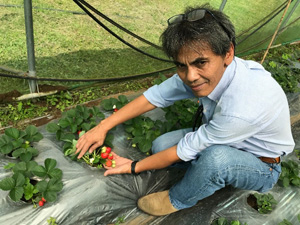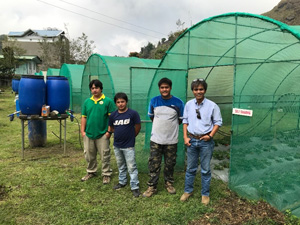 Yields of lettuce, broccoli, and strawberry increased when these were grown under a new crop shelter design developed by researcher and project leader, Dr. John F. Malamug of the Benguet State University (BSU).
Yields of lettuce, broccoli, and strawberry increased when these were grown under a new crop shelter design developed by researcher and project leader, Dr. John F. Malamug of the Benguet State University (BSU).
This was the key findings of the project, “Alternative crop shelter design for the production of high value crops in the highlands,” funded by the Philippine Council for Agriculture, Aquatic and Natural Resources Research and Development of the Department of Science and Technology (DOST-PCAARRD).
Malamug’s research was driven by the need to reduce the negative effect of climate change on crop production. Occurrences of extreme weather events such as torrential rains, drought periods, and abnormally high and low temperatures affect crop production patterns, resulting in irregular production levels.
Benguet is one of the provinces in the country vulnerable to negative effects of climate change. In his project report, Malamug said that cool season crops such as lettuce, broccoli, and strawberry grow best under “full sun” or direct unfiltered sunlight for at least six hours a day. However, intense heat generally reduces their yields. Temperature stress results in early flowering in lettuce and broccoli and smaller fruits in strawberry.
To minimize climate-induced stresses, protected crop cultivation has been recognized as one of the best adaptation measures. This method uses crop shelters and greenhouses in crop production. In lieu of expensive complicated designs, farmers in the highlands use the most common structure made of bamboo or wooden frames and covered with plastic sheets for protection. This is cheaper but it gets easily damaged during typhoons. While fine mesh white screens and plastic cladding add some protection against insects, these materials require metal pipe frames and trap excessive heat during summer.
Malamug said that double cladding is a better alternative to conventional design of crop shelters. The new crop shelter uses metal arches with two layers of cladding— the clear plastic and the green shade net with 40%, 50%, and 60% shading. An automatic weather station and sensors to monitor temperature, relative humidity, soil temperature, soil moisture, and photosynthetically-active radiation allowed Malamug and his staff to monitor and evaluate the effects of different cladding materials on crop growth and yields. The design is simple and functional, and the frame is sturdy. Results of the survey, documentation, and characterization of existing crop shelters used by farmers in Benguet provided the basis for the development of the alternative design.
 Field experiment in BSU’s research station shows that yields of Romaine lettuce and broccoli were higher in clear plastic with 40% shade net. On the other hand, yield of strawberry grown under clear plastic with 50% shade net was higher than those grown in conventional crop shelters.
Field experiment in BSU’s research station shows that yields of Romaine lettuce and broccoli were higher in clear plastic with 40% shade net. On the other hand, yield of strawberry grown under clear plastic with 50% shade net was higher than those grown in conventional crop shelters.
In actual field conditions, yield increases were much higher than those recorded in field experiment. All crops grown under the new crop shelter design increased yields of up to 46.9% for broccoli, 22.3% for lettuce, and 20.8% for strawberry. Field verification trials covered the municipalities of Atok, Buguias, Mankayan, Tuba, Kibungan, and La Trinidad.
For lettuce and broccoli, Malamug recommends the use of a double cladding of 40% shade net over clear plastic. For strawberry, he recommends the use of a double cladding of 50% shade net over clear plastic.
Double cladding is a better alternative to conventional designs. Aside from improved yields, it also offered more favorable working conditions. It provided additional structural strength to withstand strong winds and additional crop protection against extreme weather conditions.
